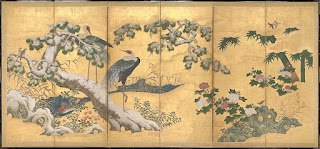16th Century Japanese Art
There has always
been something that has attracted me to Japanese art. Although I don't always
like the content, there is always something about the colors, the way the art,
whether it is the people or objects in the painting can look so delicate yet
sturdy at the same time.
The first piece is one of several silk screens from 16th
Century Japan. It shows the progression of the season called Birds and Flowers
of the Four Seasons. It has brilliant colors, strong ink outlines, gold-leaf
background, and several of the pictorial elements. Painted by Kano Motonobu
(1476–1559), founder of the Kano school of painting, while the boldness is
reminiscent of his grandson, the prolific Kano Eitoku (1543–1590). I like this
one because it shows winter on the left, and spring/summer on the right. You
can see the cranes on the left in the summer sky. It also shows the mother
protecting her nest with the father standing guard close by as one baby chick
is exploring under the tree nearby. I would have this in my house.
Kano Motonobu, Birds and Flowers of the Four Seasons, 16th century, pair of folding screens, ink, color, and gold on paper, 162.4 × 360.2 cm each (Hakutsuru Fine Art Museum, Kobe)
I am on the fence about this one.
I like the colors of the ladies’ beautiful kimonos and the way they are posed
in the painting, but there is something that irks me about all of them
"tending" to apparently his every need.
This piece is entitled: "Taiko gosai rakuto yukan no
zu"; shows Toyotomi Hideyoshi having tea and being attended to by four
women. Toyotomi Hideyoshi (February 2, 1536, or March 26, 1537 - September 18,
1598) was a preeminent daimyo, warrior, general, samurai, and politician of the
Sengoku period who is regarded as Japan's second "great unifier".
Hideyoshi is noted for a number of cultural legacies, including the restriction
that only members of the samurai class could bear arms. He financed the
construction, restoration and rebuilding of many temples standing today in
Kyoto. Woodcut by Utamaro Kitagawa, circa 1804-06.
16th century courtesans lounging on a bench under some cherry
blossom trees. The trees would show that they are outside, yet there are window
shades behind them. Again, their kimonos are made of beautiful fabric. Most
likely silk.
Kitagawa Utamaro | |
|---|---|
喜多川 歌麿 | |
 Portrait by Eishi, 1815 | |
| Born | Kitagawa Ichitarō c. 1753 |
| Died | 31 October 1806 (aged 52–53) |
| Resting place | Senkōji 35°40′47.09″N 139°35′40.71″E |
| Style | Ukiyo-e |
Kitagawa Utamaro (Japanese: 喜多川 歌麿; c. 1753 – 31 October 1806) was a Japanese artist. He is one of the most highly regarded designers of ukiyo-e woodblock prints and paintings, and is best known for his bijin ōkubi-e "large-headed pictures of beautiful women" of the 1790s. He also produced nature studies, particularly illustrated books of insects.
Little is known of Utamaro's life. His work began to appear in the 1770s, and he rose to prominence in the early 1790s with his portraits of beauties with exaggerated, elongated features. He produced over 2000 known prints and was one of the few ukiyo-e artists to achieve fame throughout Japan in his lifetime. In 1804 he was arrested and manacled for fifty days for making illegal prints depicting the 16th-century military ruler Toyotomi Hideyoshi, and died two years later.
Utamaro's work reached Europe in the mid-nineteenth century, where it was very popular, enjoying particular acclaim in France. He influenced the European Impressionists, particularly with his use of partial views and his emphasis on light and shade, which they imitated. The reference to the "Japanese influence" among these artists often refers to the work of Utamaro.
16th century japanese art - Search Images (bing.com)
Title: Birds and Flowers of the Four Seasons
Period: Momoyama period (1573–1615)
Date: late 16th century
Culture: Japan
Medium: Pair of six-panel folding screens; ink, color, gold, and gold leaf on paper
Dimensions: Image: 63 1/4 in. × 11 ft. 10 in. (160.7 × 360.7 cm)
Overall: 69 3/8 in. × 12 ft. 4 1/2 in. (176.2 × 377.2 cm)
Classification: Paintings
Credit Line: Purchase, Mrs. Jackson Burke and Mary Livingston Griggs and Mary Griggs Burke Foundation Gifts, 1987
Accession Number: 1987.342.1, .2

.jpg)


.jpg)
I really enjoyed your commentary of what “irks” you about the paintings, these paintings are beautiful with its usage of pattern especially in the kimonos. My only opinion is to not always use Wikipedia as a source for your information
ReplyDelete